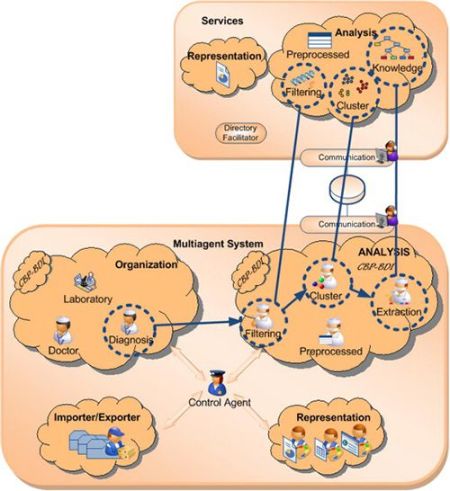IBO architecture
A researcher at the Universidad Politécnica de Madrid is participating in a research on
bioinformatics. The research has given as a result a model, Intelligent
Biomedic Organizations (IBOs), that provides data analysis from the
genetic expression.
The study, carried out in collaboration with the Universidad de
Salamanca and the Cancer Centro of Salamanca (Centro de Cáncer de
Salamanca), has proposed an organizational model specially designed to
provide medical staff with support for their daily tasks during data analysis
as well as establishing a innovative intelligent system for
classification and pattern prediction from large volumes of data. The
results obtained have shown improvements compared to previous analysis
performed manually.
The application of Information and communications technology in the
field of biomedicine has become increasingly important over
the last years. Frequently, the data analysis on bioinformatics requires conducting different sequences of actions grouped in pre-processing
stages information filtering, clustering and knowledge extraction or
classification.
The actions to perform for each stage are diverse and it required to
establish actions and the sequence of its application in the data
analysis process. This study shows an architecture that allows us to
analyze workflows for data analyzing. Depending on the results on data
streams, the system can create new flows that optimize the results.
The core of the system is involved in reasoning strategies based on
cases for the reorganization and automatic planning according to
analysis carried out previously. Basically, the system attempts to
simulate the human behavior, to seek for similar troubles on a memory of
cases and retrieve the most similar troubles with the actions
implemented.
The sequences of retrieved actions and the results can create a new
sequence of actions to be applied to the new problem. After that, the
solution is assessed and stored the result obtained to take into account
for future assessment.
The system incorporates techniques of data mining, statistics and artificial intelligence which are applied as actions to workflows. The organizational model can be applied to diverse types of data that require certain computational load.
The proposal was proved on bioinformatics for the classification of
patients by genetic analysis, particularly on patients affected by
different types of leukemia and data from brain tumors.
The system attempts to simulate medical staff behavior of
laboratories conducting the pre-processing states, information
filtering, and joining and classifying in a way that the model can
select the techniques to be applied to the stages and the generated
sequence as well as workflows analyzing automatically and enhancing the
results obtained previously in analysis performed manually.
Source: AlphaGalileo























